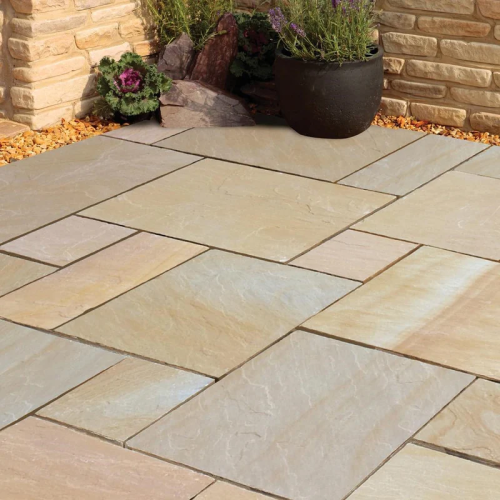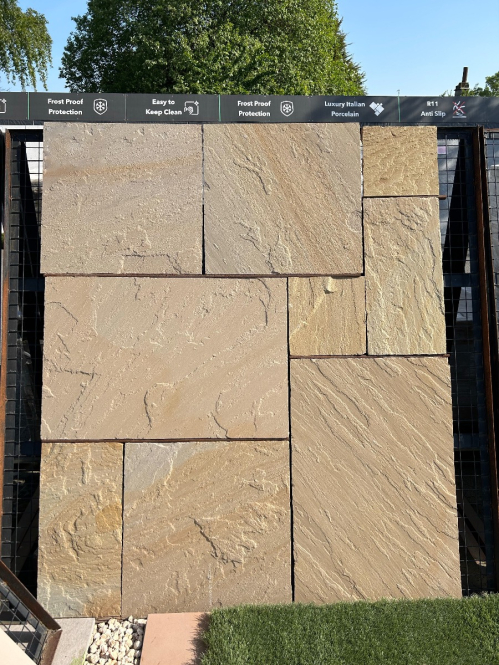Rippon Buff Sandstone
Rippon Buff is bright eye catching Indian Sandstone paving choice for your garden. Rippon buff blend is a timeless classic natural stone patio paving that is available in mixed size patio packs. Each piece is unique with beautiful gentle swirls making your patio truly unique.
Gentle fossils and swirls through the riven paving make this a stunning hard wearing choice of patio paving the ideal option for your garden area.
- Dense, heavy duty, durable natural stone paving.
- Excellent slip rating
- Extremely Hard Wearing
- Low Maintenance
If you would to find out more about our beautiful paving selection please contact one of our paving experts today.
Speak to a member of our friendly sales team today on 01482 688008 or Email sales@meltonstone.co.uk
Rippon Buff Sandstone Paving
What colour is Rippon Buff Indian Sandstone paving?
Rippon Buff Indian sandstone paving is a warm and earthy colour with a mix of light brown, buff, and golden hues. It typically features shades of beige, yellow, and light brown, resembling the natural appearance of ripened sandstone found in the Rippon area of India, from where it gets its name.
The specific colour variations in Rippon Buff sandstone can vary depending on the source and the specific quarry from which it is extracted. Natural stone always exhibits some degree of colour variation, which adds to its beauty and charm. The presence of different tones and hues within the stone creates a visually appealing and textured surface when laid as paving.
Rippon Buff Indian sandstone is a popular choice for outdoor paving projects, as its warm tones complement various landscaping styles and architectural designs. It can create a welcoming and natural ambiance in garden patios, pathways, and other outdoor spaces, enhancing the overall aesthetic appeal of the area.
As with all natural stones, it's essential to see actual samples or photographs of the Rippon Buff sandstone before making a final decision, as colours can appear differently based on lighting conditions and the surrounding environment.
Can I use brush in grout on Indian sandstone paving?
Yes, you can use brush-in grout for Indian sandstone paving. Brush-in grout, also known as brush-in jointing compound, is a type of jointing material specifically designed for filling the gaps between paving stones, such as Indian sandstone, with a brush or similar tool. It is commonly used for outdoor paving projects and provides several benefits:
1. Easy Application: Brush-in grout is simple to apply and can be easily worked into the joints using a brush or squeegee. This makes it a popular choice for DIY projects and small paving areas.
2. Weather-Resistant: Brush-in grout is typically water-resistant and able to withstand outdoor conditions, including rain and temperature changes. It helps prevent water from seeping into the joints and causing damage to the sandstone.
3. Flexibility: Brush-in grout allows for a degree of flexibility, which is beneficial for outdoor paving areas that may experience slight movement due to temperature fluctuations and other factors.
4. Reduced Weed Growth: When properly applied, brush-in grout helps reduce weed growth in the gaps between the sandstone pavers, as it forms a barrier that inhibits weed growth.
5. Quick Installation: Brush-in grout can be quicker to install compared to traditional cement-based grouts, especially for larger joint widths.
Is Flowpoint grout good for sandstone pavers?
Flowpoint grout can be suitable for sandstone pavers, but there are several factors to consider before using it:
1. Type of Sandstone: Flowpoint grout is a resin-based grout that hardens and becomes waterproof. Some sandstone varieties are more porous than others, and using a resin-based grout on highly porous sandstone may lead to potential issues. The grout might not bond well with the stone or could cause discoloration. Always test the grout on a small, inconspicuous area of the sandstone before applying it to the entire surface.
2. Joint Width: Flowpoint grout is typically recommended for joints wider than 5mm (approximately 3/16 inches). If your sandstone pavers have narrow joints, a different type of grout, such as a polymer-modified cement-based grout, might be more suitable.
3. Application and Curing: Flowpoint grout requires proper application and curing to achieve the desired results. It is crucial to follow the manufacturer's instructions carefully to ensure the grout performs as intended.
4. Sealing: Sandstone is a natural stone and can be prone to staining if not adequately sealed. Applying a suitable sealer to the sandstone before grouting can help protect it from potential staining caused by the grout.
5. Compatibility with Stone: Always check with the manufacturer of the Flowpoint grout to ensure it is recommended for use with sandstone and won't negatively affect the stone's appearance or performance.
Before using Flowpoint grout or any grout type on sandstone pavers, it's essential to consult with a professional or a knowledgeable supplier to ensure that the grout is compatible with your specific sandstone type and the intended application. Additionally, perform a small test area to assess the performance, appearance, and bonding of the grout before proceeding with the entire project.
How do I clean off flowpoint grout stains?
Flowpoint grout stains can be challenging to remove once they have dried and cured on the surface of your paving. Flowpoint is a resin-based grout that hardens and becomes waterproof, making it difficult to clean with water alone. Here are some steps you can try to clean off Flowpoint grout stains:
1. Immediate Cleaning: If the Flowpoint grout is still fresh and hasn't fully cured, you may be able to remove it with water and a stiff brush. Act quickly and gently scrub the stained areas to prevent the grout from hardening.
2. Use a Grout Remover: For dried Flowpoint grout stains, you can try using a grout remover or a specialized grout cleaner. Follow the manufacturer's instructions for the product and test it on a small inconspicuous area first to ensure it doesn't damage the paving surface.
3. Scrape off Excess Grout: If the Flowpoint grout has dried but hasn't cured completely, you can carefully scrape off the excess grout using a plastic or rubber-edged grout float. Be gentle to avoid scratching or damaging the paving.
4. Chemical Solutions: If the grout stains persist, you may need to use chemical solutions to dissolve the grout. However, be cautious when using strong chemicals, as they can potentially damage the paving or affect its colour. Always follow the instructions and recommendations of the chemical product you are using.
5. Pressure Washer: In some cases, a pressure washer may help to remove stubborn Flowpoint grout stains. Use a fan nozzle and maintain a safe distance from the surface to avoid damaging the paving.
6. Professional Cleaning: If the stains are particularly stubborn or widespread, consider seeking professional help from a stone cleaning specialist who has experience in removing grout stains from paving.
How thick are sandstone wall copings?
The thickness of wall copings, also known as "coping depth" or "coping thickness," depends on several factors, including the height of the wall, the material used for the coping, and the structural requirements. Copings serve as protective caps for walls, providing a finished edge and helping to redirect water away from the wall's surface. The recommended thickness for wall copings typically ranges from 2 inches (5 centimetres) to 4 inches (10 centimetres). However, thicker copings may be used for specific applications or for walls with greater height or load-bearing requirements.



